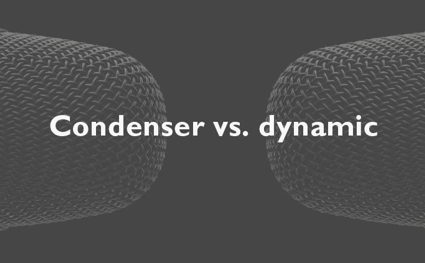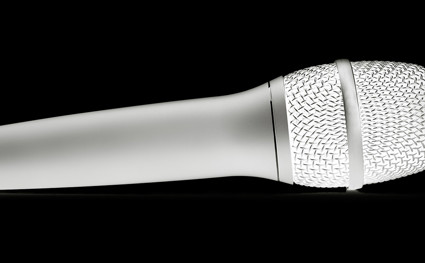Proximity effect in microphones explained - how it affects different sound sources
Proximity is when a microphone produces more bass by getting closer to the sound source (a point - or line source). This article takes you through some of the basics of proximity – and introduces a more advanced perspective on the phenomenon.
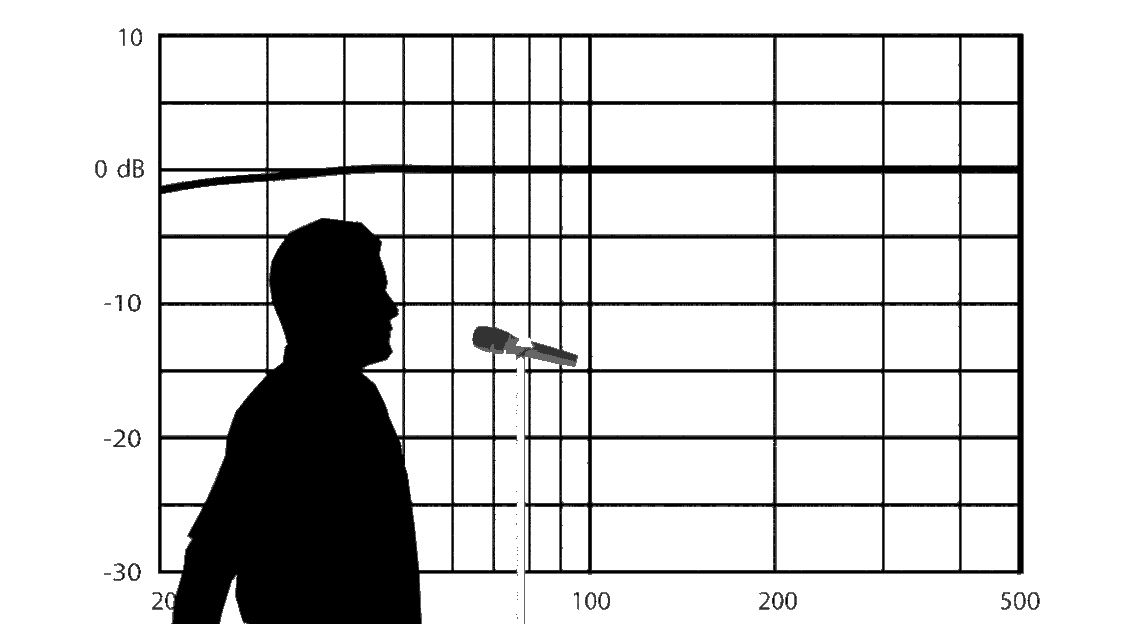
The effect of proximity is well-known to most sound engineers. The singer's voice gets more bass when the microphone moves closer to the mouth. As the microphone moves away, the sound gets thinner.
Proximity only exists with gradient-types of microphones – wide cardioid, open cardioid, cardioid, super-cardioid, hyper-cardioid, figure of eight – and everything in between. Thus, the closer the directionality pattern comes to a figure of eight, the more proximity is exhibited. Also, the proximity effect is strongest on-axis. If you turn the microphone, the proximity effect is reduced.
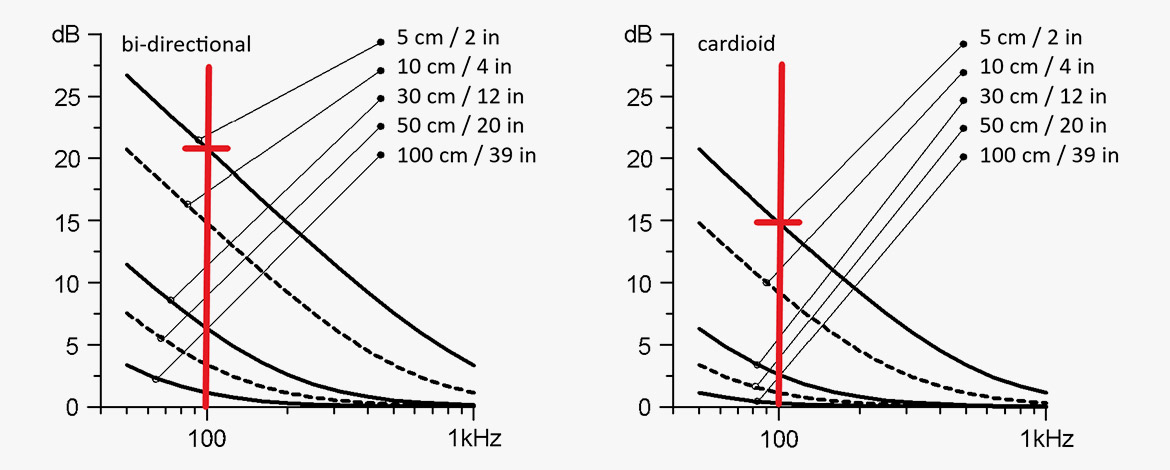
Figure 1. The diagrams show the proximity effect of two gradient microphones, a figure-of-eight, and a cardioid. Compare the microphones' bass lift at 100 Hz. The proximity is much higher in the figure-of-eight (bi-directional) microphone than in the cardioid.
Note that the proximity effect, by design, sometimes provides a flat response when the mic is close to the source (i.e., vocal microphones) – or provides a flat response when the microphone is further than 1 meter away from the sound source (in distant recording or the like). For this reason, when evaluating this information for gradient microphones (for example in a spec sheet), the distance at which the frequency response is neutral/flat should be stated.
Be aware that pressure microphones (omnidirectional microphones) do not exhibit proximity. This is because the sound has only admittance to the front of the diaphragm. A pressure microphone is basically a diaphragm in front of a closed chamber.
The sound sources
Proximity is dependent on the sound source. A point source generates a spherical sound field where the SPL drops by 6 dB/doubling distance. A gradient microphone close to a point source (<1 m) exhibits proximity. If, however, the sound source is either an (infinite) plane source or a point source at some distance (>1 m), practically no proximity effect exists.

Figure 2. A point source is essentially a sizeless pulsating sphere. A certain amount of sound energy is generated and distributed evenly in all directions away from the point. The further away you get, the more the sound is diluted as the sound energy is distributed throughout a greater area. A microphone records -6 dB per doubling of the distance.
The SPL from point sources drops by 6 dB/doubling of distance.
The SPL from line sources drops by 3 dB/doubling of distance.
The SPL from plane sources drops by 0 dB/doubling of distance.
You would think that the world should be extremely noisy, having sound sources from which the sound level never drops. However, this is only the case if the plane sources have infinite size – they do not. Thus, any plane source acts as a point source at a distance. Below you can see a practical example of this phenomenon.
The sound source is a studio monitor (Genelec 8341A). This speaker has coaxial/symmetrical arranged membranes for low, mid and high frequencies, respectively. The cross-over frequencies are 500 Hz and 3 kHz.
The signal reproduced by the loudspeaker is pink noise.
Measurement distances are 64, 32, 16, 8, 4, 2 and 1 cm, respectively.
When moving from 64 cm to 32 cm or from 32 cm to 16 cm, the sound pressure increases by 6 dB at all frequencies. If, however, moving from 8 cm to 4 cm or from 4 cm to 2 cm, the low frequencies stay almost constant, while the higher frequencies still increase. When moving from 2 to 1 cm (from red to blue curve), only frequencies above 3 kHz increase. The measurements are conducted using an omnidirectional microphone (no influence from proximity effect).
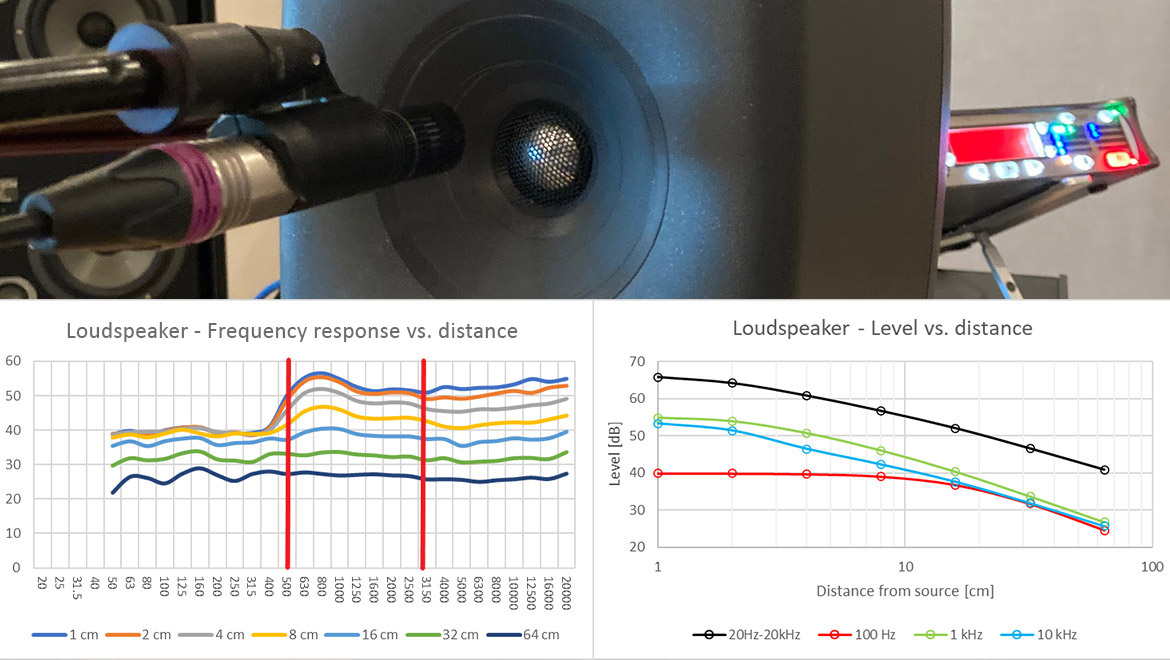
Figure 3. Sound level vs. distance from a monitor loudspeaker (coaxial units). Signal: Pink noise. Measurements are taken at 64, 32, 16, 8, 4, 2 and 1 cm, respectively. The diagram to the right shows level vs. distance at three individual frequencies (100 Hz, 1 kHz and 10 kHz) and a frequency band (20 Hz – 20 kHz).
Why proximity?
So, proximity exists only in gradient microphones. The explanation is that sound hits the diaphragm from both the front and the back. (There is an inlet to the rear side of the diaphragm). The pressure difference between the front and rear (the gradient) creates the diaphragm's movement. The distance from the front to the rear is in the range of 1-2 cm. At a low frequency (exhibiting a long wavelength of several meters), the pressure difference across 1-2 cm of a soundwave is small. At higher frequencies, this difference increases (see Microphone technology – the essentials, fig. 4 and 5).
Apart from this primary gradient, there is another added pressure difference when you get close to the microphone (≤1 m). This is related to distance. If you have a sound source 2 cm from the front side of the diaphragm, then the distance to the rear is farther (let's say 4 cm in this example). The distance to the rear side is now double the distance to the front. If the sound source is a point source, the sound pressure is attenuated by 6 dB from the front to the rear of the diaphragm. This must be regarded as an additional gradient. However, it only gets effect at low frequencies because the primary gradient is weak in this range.
To conclude, we have a bass lift when the microphone is close to a point source.
On-axis vs. off-axis
In a soundwave, the distance between the front and the rear also depends on the angling of the microphone. When the microphone is pointing directly towards the sound source, the distance reaches its maximum. When not on-axis, the distance difference is reduced and there is less proximity effect. If the soundwave has the same distance to the front and the rear, no proximity effect exists. For a cardioid microphone, this happens when the angle is exactly 90 degrees. If the microphone is rotated further from the proximity-neutral angle, the effect shows up again. So, if the microphone is completely off-axis (around 180 degrees), proximity effect will again be present.
When proximity?
Basically, proximity effect occurs when sound comes from a point source or a line source, the microphone is a gradient type, and it is pointing towards the sound source. Proximity effect does not occur when the sound source is a plane source, the microphone is a pressure type, or the microphone is pointing to the side. However, in between these specific conditions, there are variations.
The equivalent sound source can be challenging to predict or define when it comes to musical instruments. Below you'll find some examples.
Trumpet
Sometimes, the proximity effect does not come into play due to the instrument's frequency response. For instance, a trumpet is basically defined as a point source. However, the spectrum does not extend to the bass range. Thus, proximity is not a challenge when recording this instrument.

Figure 4. Nearfield recording of a trumpet. The curves show the difference between a cardioid (4011 Cardioid Mic) and an omnidirectional mic at various distances (the measurements are subtracted from each other). The instrument's frequency range causes only a limited degree of proximity effect within the actual frequency range. The distance-based level difference is taken out (for easier comparison of curves).
Grand Piano
A grand piano (the space just above the strings) is regarded as a plane source even though the individual strings might be seen as something else. The levels are relatively constant at 2, 4, 8 and 16 cm. There is no proximity effect (nothing to emphasize low frequencies).
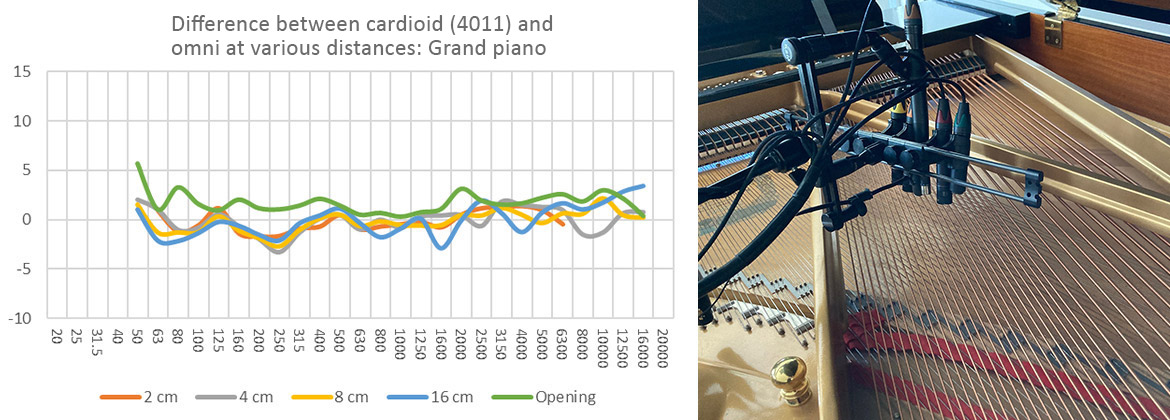
Figure 5. Nearfield recording of a grand piano. The curves show the difference between a cardioid (4011) and an omnidirectional mic at various distances. The instrument's frequency range causes no proximity effect. The distance-based level difference is taken out (for easier comparison of curves).
Acoustic guitar
An acoustic guitar (microphones centered at the front of the top wood sound board, below the bridge) is a plane source at small distances. However, the spectrum is not that attractive in this position, so other microphone positions are usually preferred, mostly because the sound from the body hole is strong here.

Figure 6. Nearfield recording of an acoustic guitar (in front of the top wood sound board, just below the bridge). The curves show the difference between a cardioid (4011) and an omnidirectional mic at various distances. The distance-based level difference is taken out (for easier comparison of curves).
Kick drum
You might expect the drumhead of a kick drum to function as a plane source due to the significant diameter of the skin. However, its behavior is closer to a point source. The drumhead is not a pure plane source at any distance – so proximity exists. Therefore, care must be taken when selecting a microphone. It should not be too dependent on the gradient component.
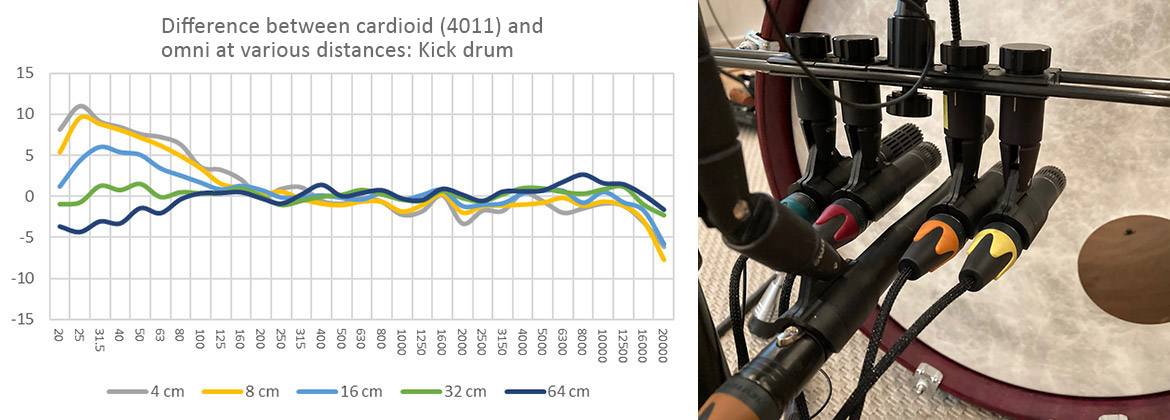
Figure 7. Nearfield recording of a kick drum. The curves show the difference between a cardioid (4011) and an omnidirectional mic at various distances. The curves show the resonator head behaves more like a point source than a plane source. The distance-based level difference is taken out (for easier comparison of curves).
The newly developed DPA 4055 Kick Drum Microphone is a gradient microphone with an "open cardioid" characteristic. It sits between "wide cardioid" and "cardioid." This means the proximity effect exhibited is less than that of a cardioid microphone. However, it exhibits a complete low-frequency response, even at a distance. So, it gives the engineer the freedom to place the microphone at a convenient distance without the vibrating skin hitting the microphone.

Typical polar pattern of a 4055.
Further, it is designed to manage the excessive sound levels around and inside the drum. This microphone does not necessarily have to point directly towards the resonator head, the resonator head hole or the hammer area close to the batter head. It provides excellent opportunities for experimenting with placement outside and inside the drum to pick up the sound with the right impact as the situation requires.
AMENDMENT - How was it measured?
Each music instrument was recorded simultaneously with several microphones. Afterward, the signals were analyzed using Smaart Live, spectrum, 1/3 octave band, averaging time >1 minute.
The data (the spectra) were transferred to a spreadsheet for each of the recording distances (64, 32, 16, 8, 4, 2, and 1 cm to the extent these data were available).
Now, for each distance, the data of the omni microphone recordings were subtracted from the data of the cardioid microphone. The resulting curve thus shows the difference between the two microphones. If there were no difference, it would be close to a straight horizontal line. (However, the sensitivity difference has been compensated for). If proximity exists, there is a rise in low-end frequencies.


